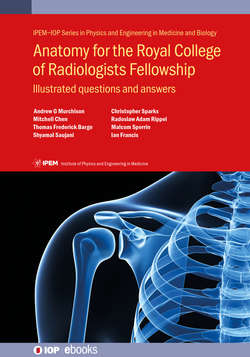Читать книгу Anatomy for the Royal College of Radiologists Fellowship - Malcolm Sperrin - Страница 12
На сайте Литреса книга снята с продажи.
Q1.4 Axial slice from a CT cisternogram study with intrathecal contrast
Оглавление1 Name the arrowed structure.
2 Name the arrowed structure.
3 Name the arrowed structure.
4 Name the arrowed structure.
5 Name the arrowed structure.
Answers
1 Left gyrus rectus (straight gyrus).
2 Pituitary infundibulum (pituitary stalk).
3 Interpeduncular cistern.
4 Cerebral aqueduct (aqueduct of Sylvius).
5 Quadrigeminal cistern.
Comments:
The basal cisterns are a network of cerebrospinal fluid (CSF)—filled spaces which communicate with the ventricular system via the Foramen of Magendie (also called the median or medial aperture) and the two lateral Foramina of Luschka (lateral apertures)—these drain into the cisterna magna, which sits at the base of the skull between the medulla and cerebellum.
Cisterns that you should be able to identify include the suprasellar cistern, which sits above the pituitary fossa (sella turcica) and contains important structures including the Circle of Willis and the optic chiasm. The suprasellar cistern has a star-shaped configuration, with the posterior point of the star formed by the interpeduncular fossa, which lies between the two cerebral peduncles of the midbrain. The two posteriolateral points of the star are the ambient cisterns which are lateral to the brain stem; these join posteriorly behind the midbrain to form the quadrigeminal cistern. The anterolateral points of the star are the Sylvian fissures (lateral sulci), which separate the frontal and parietal lobes from the temporal lobes, and contain the middle cerebral arteries.
Other cisterns to recognise are the prepontine and premedullary cisterns, which are best seen on sagittal images and lie in front of the pons (with its’ belly) and the medulla, respectively.
Exam tips:
The quadrigeminal cistern can be mistaken for the fourth ventricle. The quadrigeminal cistern is seen at the level of the midbrain (which has ‘Mickey Mouse ears’)—the fourth ventricle is seen at the level of the pons. An additional clue in question 5 is that the cerebral aqueduct, which drains from the third to the fourth ventricle, is also visualised; therefore this cannot be the fourth ventricle.
Question 2 is difficult because it is an obscure view of a common structure. The key here is to orientate yourself—it is a midline structure in the suprasellar cistern, lying just behind the optic chiasm.
